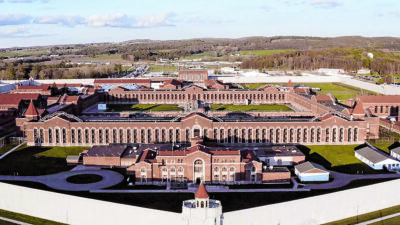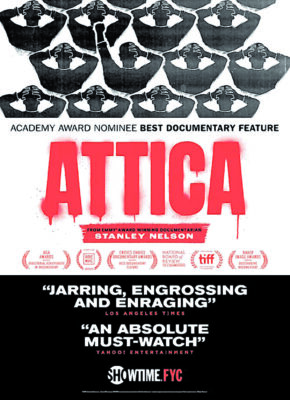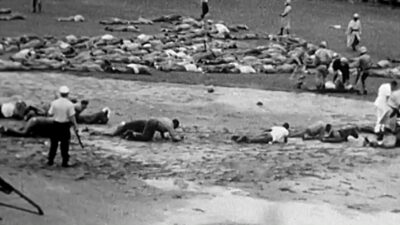September 9, 2021 marked the 50th anniversary of the prison rebellion that blew up in Attica, NY. At this insurrection, more than 1,200 inmates seized the maximum security prison yard in this tiny Western New York community that lay 35 miles east of Buffalo. The standoff ended on September 13, when then-Governor Nelson Rockefeller authorized law enforcement to storm and retake the facility through violent means. Tear gas was dispersed over the yard as a 1,000-strong, armed state trooper contingent descended on the yard, guns a-blazing. Once the gas cleared, 29 inmates and 10 hostages were killed, with 89 others wounded.

(Photo courtesy of SHOWTIME)
With this historic incident spurred on by inmates seeking better living conditions, it wound up being an inflection point in the prisoners’ rights movements that was referenced in films like 1975’s Dog Day Afternoon and 1977’s Saturday Night Fever. For filmmaker Stanley Nelson, it’s an event that’s weighed on his mind for the past three decades and led to his shooting the documentary Attica, which was in the running for the Oscar for Best Documentary Feature at the 94th Academy Awards ceremony.
“When it happened, I was 19 or 20 years old,” the 70-year-old documentarian recalled. “I remember going, ‘Oh my God, they’re taking over the prison.’ Not only had they taken over the prison, but they’ve taken over hostages so law enforcement can’t retake the prison without a massive loss of life. That was day-to-day and then finally, there were the actions Governor Nelson Rockefeller took. I think, like so many other people, I felt a sense of awe and shock about that fact and what they actually did.”
 While the notion about revisiting Attica floated around in Nelson’s mind for the past three decades, he also realized if he was going to tell this story, he was going to have to start his research and start filming, something he began in earnest about four years ago.
While the notion about revisiting Attica floated around in Nelson’s mind for the past three decades, he also realized if he was going to tell this story, he was going to have to start his research and start filming, something he began in earnest about four years ago.
“With the idea of making a film about Attica floating about in the ether, I realized we had to make the film soon because the people involved in the Attica rebellion were getting older,” he said. “The people we have in the film are great, but we couldn’t wait another 10 or 20 years to make the film. That’s when we really started pushing to get it done.”
Click here to read about Stanley Nelson’s favorite documentaries.
At a time when protests over the Vietnam War and civil rights were raging, that sense of outrage over humanitarian abuses were flowing through prison systems across the country. One of the more notable incidents prisoners in the documentary cite was the shooting death of prisoner/activist George Jackson by guards at San Quentin weeks before the Attica uprising. It’s a crucial piece of the film that Nelson’s archival researcher, Rosemary Rotondi, felt needed to be included.
“Stanley wanted to have the George Jackson story in there because spiritually, Jackson’s murder was one of the earlier events that preceded Attica,” Rotondi explained. “We were able to find two great interviews Jackson did—one with KPIX in California that we located at a Bay Area TV archive, and another with Jackson that Thames TV in the U.K. did about a month before Jackson was killed.”

(Photo courtesy of SHOWTIME)
In working with co-director Traci A. Curry and Rotondi, Nelson undertook the herculean task of assembling footage that included color footage shot by the three major networks—ABC, CBS and NBC—along with their local affiliates. In addition, Nelson reached out to the New York State Archives, which acquired black-and-white footage from the prison closed-circuit surveillance system about 12 years ago and provided a real-time perspective of the siege unfolding from the vantage point of the prison towers and ramparts. Most important were the first-hand accounts of the people who were there—prisoners, hostage family members and journalists like John Johnson and Stewart Dan covering the rebellion, along with members of a hand-picked observers committee sent into negotiate terms prisoners required before surrendering. Inmates made 33 demands that included better medical treatment, religious freedom, improved food quality, access to newspapers and books, fair visitation rights, basic necessities like daily showers and toothbrushes and an end to physical abuse.
Among the negotiators, Nelson and his team secured current interviews with were State Senator John Dunne, who was the head of a Prisons Committee in the New York State Legislature and Clarence Jones, publisher of the Amsterdam News and former advisor to Martin Luther King, Jr. For Nelson, Jones agreeing to be interviewed was a major coup for the film.
“Getting him was one of the big things for us in the making of the film,” Nelson said. “He lives out in the San Francisco Bay Area and was here in New York for something. We met him for coffee in the morning and told him what we were trying to do. He started telling us stories and we realized that he had this incredible memory of Attica. He’s just an amazing storyteller and human being. He was Martin Luther King’s personal lawyer and co-wrote the ‘I Have a Dream’ speech. He has four or five different lives. At the time of the Attica rebellion, he was publisher of The Amsterdam News. We met with him, he was telling us these great stories. I asked if he would consent to us interviewing him. He said, ‘Yes Stanley, whatever you want, I’ll do it.’ A real signifying point in the making of the film was when Clarence consented to be interviewed.”
Interviews were conducted by Curry in 2019, early 2020 and through 2021, even as the pandemic arrived and raged on, providing additional obstacles beyond tackling a topic as complicated as Attica.
“The whole film was made during the time of COVID-19,” Nelson said. “We were scheduled to shoot in April 2020 and [the pandemic] struck in March. We couldn’t shoot and had to figure out how we could do it. In many ways, we let other people get out there first and shoot. We talked to a lot of other camera crews, directors and producers on how they were shooting. I think everybody we interviewed was around 70 years old, so they were the extra-vulnerable population. And we really didn’t want this film to look like we shot it during COVID-19.”
Paramount for the Attica crew was presenting a 360-degree view of this story, which meant providing a platform for the hostage families and the community that surrounded the prison.
“One of the challenges was getting people to understand what we were trying to do and getting people to trust us,” Nelson said. “Not only the prisoners, but the hostage families that lived in Attica. They really add something to the film. It’s a hard film to describe because you’re not only right there with the prisoners who rebel and in the yard with them because there’s footage of that, but the town of Attica is also a character in the film. It’s an all-white town that basically survived on the prison. We interviewed people from the town whose fathers and husbands were prison guards and they talked very honestly about the fact that it’s a prison town. And that most of their neighbors were in some way connected to the prison. Again, they’re all white and the prison is 70 percent black and brown.”
Given how intrinsically race was linked to this power keg of an incident, it should come as no surprise that the law and order mindset guided Rockefeller’s decisions like refusing to come to Attica and negotiate with the prisoners. These were views shared by President Richard Nixon, whose recorded conversations with the governor about what was going on at the prison are included in the film.
“One of the more chilling points in the film are calls between Rockefeller and Nixon that luckily, Nixon recorded, so we have those calls,” Nelson said. “[Nixon] calls Rockefeller to congratulate him on the retaking of the prison and the murdering of 40 American citizens. The first thing out of Nixon’s mouth was, ‘Was it the blacks? Were the blacks responsible?’ There is so much of this in the film and it’s a real rollercoaster ride.”

overflowing with feces after Attica was retaken by law enforcement
(Photo courtesy of SHOWTIME)
The last quarter of the film focusing on the prison being retaken is particularly difficult to watch. Armed state troopers, whose sense of retribution was goaded on by racist-fueled bloodlust, indiscriminately shot through the tear gas, inadvertently killing 10 of their own, along with 29 inmates. Once the area was secured, revenge came in the form of hunting down inmate leaders like Elliott James “L.D.” Barkley, who was prominently featured in news coverage, and shooting him in cold blood. Surviving prisoners were forced to strip naked and crawl through the feces of overflowing latrines inmates had dug, before forcing them to run barefoot through a gauntlet of broken glass lined by law enforcement raining down blows with clubs as prisoners scurried through. It adds a particularly troubling and uncomfortable exclamation point to the film for Nelson.
“There is so much that’s disturbing in the film,” Nelson said. “The footage of them being made to crawl through mud and the feces of the latrine was just incredible. So many of the things they talk about are directly illustrated and you see what people were describing. That’s also chilling. Over and over again, [you experience] the casual racism we see in the film. As they’re shooting and filming on top of the towers, you hear [law enforcement]talking about the biggest, blackest and ugliest Negro gentleman they’ve ever seen. And when they take back the prison and kill 40 people in cold blood, we see them laughing about it and yelling white power.”
While Nelson and his crew have deservedly received accolades for Attica at various film festivals and ceremonies, most notably at the upcoming Oscars, where he wound up losing to the heavily favored Summer of Soul, the septuagenarian filmmaker’s true goal is getting people to think after watching his film. It’s all the more relevant given the current law and order conversation swirling around discussions of bail reform, progressive prosecutors and a rising crime rate coming out of the pandemic.
“I think we’re still dealing with the same struggles—law enforcement, decency and humanity and people wanting to be treated like human beings,” Nelson said. “Hopefully, a bunch of things are coalescing at the same time and for a tiny bit of that, it’s the film Attica making people start to rethink the prison system. As filmmakers, we try to keep insight as to what our real goals are and what they are here is making sure we have as many people as possible see the film. The awards nods are all great, but in the final analysis, that will push more people to recognize and see the film and that’s what we really want.”



















